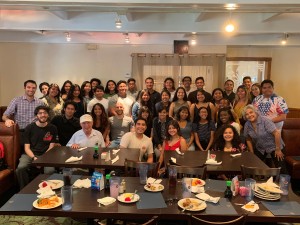Biology Professor Explores Improving Student Success in STEM

Cohort of students involved in the Math and Language Arts Summer program in 2019. Photo courtesy of MariaElena Zavala.
Science, technology, engineering and mathematics (STEM) permeates every part of our lives. In the 21st century, scientific and technological innovators have become increasingly important as we tackle challenges of global climate change and renewable clean energy.
California State University, Northridge professor of biology MariaElena Zavala is working to prepare the next generation of STEM professionals through a unique five-week summer program in mathematics and language arts for entering freshman.
The program works with underrepresented Pell-eligible students – students who have a high degree of unmet financial need – who are not well represented among the high preforming STEM students.
“The inspiration for the program is based on a report I came across from many years ago. It showed that students who had to receive extensive remediation in math at CSUN, no matter what their majors were, were less likely to continue and earn an undergraduate degree,” Zavala said.
The math and language arts summer program consists of five weeks of daily workshops, with three days devoted to math enhancement, one to English enhancement and one for field trips to science centers and marine environments. The program works across three CSUN colleges, including science, mathematics, social behavioral science and health and human development and nine departments – biology, chemistry, physics, mathematics, psychology, nutrition, public health, kinesiology, and environmental health sciences.
The objective of the math and language arts summer program is to increase the pool of students to pursue science degrees, but also to increase the number of eligible students who can apply to the MARC/RISE programs – special research training programs funded by the National Institutes of Health.
“Our goal was to have 90 percent of students who participated in the program to be able to improve their performance in the math placement exam,” Zavala said. “Another goal, was to see that they would then pass their freshman math classes at a higher rate.”
In an 11-year study conducted by Zavala, Steven Oppenheimer and four other researchers beginning 2009, cohorts of students involved in the program were monitored to track their progress. The results showed that out of 308 students involved, 90 percent attempted a math class, with 85 percent of students passing with a “D” or better. The overall GPA of the participants was higher, and the six-year graduation rate was 68 percent for these students.
“It turns out, that students who did participate in the program were more successful than those who didn’t,” Zavala said. “These programs allow students to become aware of the opportunities they have and realize that they are capable of being successful.”
Moving forward, Zavala said that the next step will be to expand the program across the entire college of science and mathematics with the hope of getting more students to participate and be more successful in their lower division classes.
“The more successful students are, the more they become eligible to apply to research-based internships at CSUN and across the nation,” Zavala said.

 experience
experience